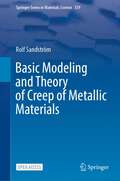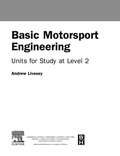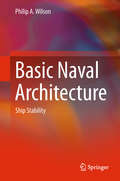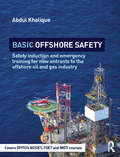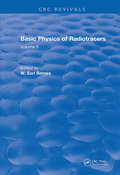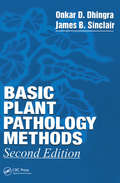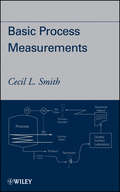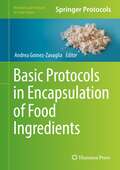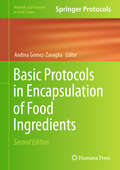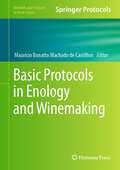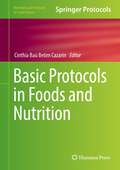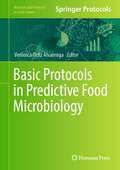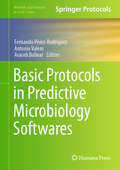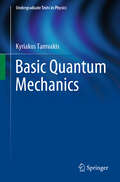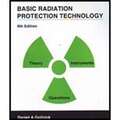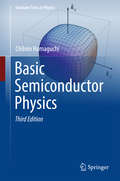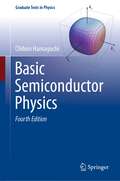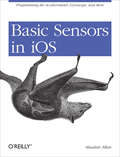- Table View
- List View
Basic Metrology for ISO 9000 Certification
by G. M. de SilvaTraceable calibration of test and measurement equipment is a requirement of the ISO 9000 series of standards. Basic Metrology for ISO 9000 Certification provides essential information for the growing number of firms registered for ISO 9000. Dr. G.M.S. de Silva who has a lifetime of experience in metrology and quality management fields condenses that knowledge in this valuable and practical workbook. The book provides a basic understanding of the principles of measurement and calibration of measuring instruments falling into the following fields; Length,Angle, Mass, Pressure, Force, Temperature and AC/DC Electrical quantities. Basic concepts and definitions, ISO 9001 requirements and uncertainty determinations are also included.
Basic Modeling and Theory of Creep of Metallic Materials (Springer Series in Materials Science #339)
by Rolf SandströmThis open access book features an in-depth exploration of the intricate creep behavior exhibited by metallic materials, with a specific focus on elucidating the underlying mechanical properties governing their response at elevated temperatures, particularly in the context of polycrystalline alloys. Traditional approaches to characterizing mechanical properties have historically relied upon empirical models replete with numerous adjustable parameters, painstakingly tuned to match experimental data. While these methods offer practical simplicity, they often yield outcomes that defy meaningful extrapolation and application to novel systems, invariably necessitating the recalibration of parameters afresh.In stark contrast, this book compiles a compendium of models sourced from the scientific literature, meticulously crafted through ab initio methodologies rooted in fundamental physical principles. Notably, these models stand apart by their conspicuous absence of adjustable parameters. This pioneering effort is envisioned as a groundbreaking initiative, marking the first of its kind in the field. The resulting models, bereft of arbitrary tuning, offer a level of predictability hitherto unattained. Notably, they provide a secure foundation for ascertaining operational mechanisms, contributing significantly to enhancing our understanding of material behavior in high-temperature environments.This open access book is a valuable resource for researchers and seasoned students engaged in the study of creep phenomena in metallic materials. Readers will find a comprehensive exposition of these novel, parameter-free models, facilitating a deeper comprehension of the intricate mechanics governing material deformation at elevated temperatures.
Basic Motorsport Engineering
by Andrew LiveseyMotorsport is not just about the spectacle of some of the world's most popular and famous sporting events - it also plays a crucial role in developing new techniques and technologies. Each unit in the IMI and EAL level 2 courses are covered in full, and the chapters can be easily matched to the BTEC First course structure. The book covers introductory topics in motorsport from vehicle science and maths through the basics of vehicle maintenance to pre and post race inspections.Written by an experienced teacher and author with decades of involvement with the industry, packed with detailed colour illustrations and learning tips, Basic Motorsport Engineering is the perfect textbook for you to make the first move into this most dynamic of industries.
Basic Naval Architecture: Ship Stability
by Philip A. WilsonThis textbook provides readers with an understanding of the basics of ship stability as it has been enacted in international law. The assessment of ship stability has evolved considerably since the first SOLAS convention after the sinking of the HMS Titanic, and this book enables readers to familiarise themselves with the most up-to-date modern day methodology, as well as looking ahead to the effects on ship design over the next fifty years. The author not only explains the methodology of probabilistic ship damage as required by the International Maritime Organisation (IMO), but also details the new requirements to assess certain sizes and classes of ships to the seven second-generation ship stability requirements. Many textbooks that are currently used by undergraduates focus on the geometric-centric deterministic approach to the assessment of ship stability, whereas this book also includes material on the classes of ships that are now required to have probabilistic ship damage assessment, as has only recently been agreed by the IMO. Basic Naval Architecture: Ship Stability contains up-to-date information, making it ideal for university students studying ocean or marine engineering, as well as being of interest to students on naval architecture and ship science courses. Highly illustrated and including chapter studies for ease of learning, the book is an ideal one-volume textbook for students.
Basic Offshore Safety: Safety induction and emergency training for new entrants to the offshore oil and gas industry
by Abdul KhaliqueComprehensive insight into the offshore oil and gas industry for those intending to choose it as a career Full syllabus coverage for OPITO BOSIET, FOET, MIST and IMIST courses Produced in full colour with over 180 images Basic Offshore Safety covers everything that newcomers to the offshore oil and gas industry need to know ?prior to travelling offshore or when attending OPITO's Basic Offshore Safety Induction and Emergency Training (BOSIET), Minimum Industry Safety Training (MIST), Further Offshore Emergency Training (FOET) and International MIST courses. Primarily focused on the oil industry, this book introduces readers to the key safety topics in the offshore support vessel industry and common to the renewable industry. Written in easy to follow steps and including references to both the legislation and guidance where relevant, Abdul Khalique walks the reader through the hazards they are likely to encounter when travelling to, from or working offshore, showing how to minimise risks and deal with any issues that may arise at any stage of the work.
Basic Physics Of Radiotracers: Volume II (CRC Press Revivals)
by Lelio G. Colombetti W. Earl BarnesThe opportunity to present the physics of radioactive processes in some detail apart from topics such as instrumentation which conventionally compete with it for spacer is most welcome. The material is intended to give a fairly complete introduction to radiation physics to those who which to have more than a descriptive understanding of the subject. Although it is possible to work one’s way through much of the subject matter without having any previous physics background, some prior acquaintance with modern physics is desirable. A familiarity with calculus and differential equations is also assumed. Volume I begins with a brief description of classical physics, it’s extension to special relativity and quantum mechanics, and an introduction to basic atomic and nuclear concepts. A thorough discussion of atomic structure follows with emphasis on the theory of the multielectron atom, characteristic X-rays, and the Auger effect. Volume II treats the subjects of nuclear structure, nuclear decay processes, the interaction of radiation with matter, and the mathematics of radioactive decay.
Basic Plant Pathology Methods
by James B. Sinclair Onkar Dev DhingraThe Second Edition of this bestseller brings together basic plant pathology methods published in diverse and often abstract publications. The Second Edition is updated and expanded with numerous new figures, new culture media, and additional methods for working with a greater number of organisms. Methods are easy to use and eliminate the need to seek out original articles. This reference allows for easy identification of methods appropriate for specific problems and facilities. Scientific names of pathogens and some of their hosts are updated in this edition. The book also acts as a research source providing more than 1,800 literature citations.The Second Edition includes chapters on the following:Sterilization of culture apparatus and culture mediaCulture of pathogens with detailed techniques for 61 fungi and selected bacteriaLong-term storage of plant pathogensDetection and estimation of inoculum for 28 soilborne fungal pathogens and 5 bacterial genera-15 methods for airborne inoculum and 13 methods for seedborne pathogensEstablishment of disease and testing for disease resistanceWork with soil microorganismsFungicide evaluationBiological controlBright-field microscopy
Basic Principles for Construction (Second Edition)
by Mark W. HuthThis text provides a solid foundation to learn the major trade areas--carpentry, electrical wiring, HVAC, plumbing, and facilities maintenance.
Basic Principles of Concrete Structures
by Yong Zhou Xianglin Gu Xianyu JinBased on the latest version of designing codes both for buildings and bridges (GB50010-2010 and JTG D62-2004), this book starts from steel and concrete materials, whose properties are very important to the mechanical behavior of concrete structural members. Step by step, analysis of reinforced and prestressed concrete members under basic loading types (tension, compression, flexure, shearing and torsion) and environmental actions are introduced. The characteristic of the book that distinguishes it from other textbooks on concrete structures is that more emphasis has been laid on the basic theories of reinforced concrete and the application of the basic theories in design of new structures and analysis of existing structures. Examples and problems in each chapter are carefully designed to cover every important knowledge point. As a basic course for undergraduates majoring in civil engineering, this course is different from either the previously learnt mechanics courses or the design courses to be learnt. Compared with mechanics courses, the basic theories of reinforced concrete structures cannot be solely derived by theoretical analysis. And compared with design courses, this course emphasizes the introduction of basic theories rather than simply being a translation of design specifications. The book will focus on both the theoretical derivations and the engineering practices.
Basic Principles of Nanotechnology
by Wesley C. SandersThe book allows the reader to have a basic understanding of the structure and properties of nanoscale materials routinely used in nanotechnology-based research and industries. To add, the book describes the operation of nanoscale transistors and the processes used to fabricate the devices. Additionally, it presents research involving the use of carbon nanotubes, graphene, and molecules to create non-silicon based electronic devices. It aims to provide an understanding of the operation of the most frequently used fabrication and characterization procedures, such as scanning electron microscopy, atomic force microscopy, etch, e-beam lithography, and photolithography.
Basic Principles of Topography (Springer Geography)
by Blagoja MarkoskiThis book gives a comprehensive overview of all relevant elements in topography and their practical application. It elaborates on the classical representation of terrain on maps such as cartographic projections, together with their classification, scale, and geographical elements. It is richly illustrated with photographs, maps and figures, in which the theoretical explanations are clarified. Readers will become acquainted with the physical characteristics of the ground, i. e. tectonic and erosive shapes, the importance and classification of terrain, genetic (fluvial, abrasive, glacial, karst) and topographic types such as higher (mountains, hills, peaks) and lower terrain (valleys, fields). In addition, the book discusses cartometry and coordinate systems, orientation in space (geographic, topographic, tactical) including by means of maps, instruments and the night sky and elaborates new techniques and technologies such as aerial photogrammetric imagery, global navigation satellite systems and LiDAR. The book also includes methods for the practical execution of concrete measurement operations, such as determining position and movement on land with maps, compass and azimuth which makes it especially useful for practitioners and professionals, e. g. , for landscape planning, military exercises, mountaineering, nature walks etc. As such it offers a valuable guide not only for undergraduate students but also for researchers in the fields of geography, geosciences, geodesy, ecology, forestry and related areas looking for an overview on topography. Uniquely, the book also features an extensive glossary of topographical terms.
Basic Process Measurements
by Cecil L. SmithA unique resource for process measurementBasic Process Measurements provides a unique resource explaining the industrial measuring devices that gauge such key variables as temperature, pressure, density, level, and flow. With an emphasis on the most commonly installed technologies, this guide outlines both the process variable being measured as well as how the relevant measuring instruments function. The benefits of each technology are considered in turn, along with their potential problems. Looking at both new and existing technologies, the book maintains a practical focus on properly selecting and deploying the best technology for a given process application.The coverage in Basic Process Measurements enables the practitioner to: Resolve problems with currently installed devices Upgrade currently installed devices to newer and better technologies Add instruments for process variables not previously measurable Evaluate device installations from a perspective of both normal process operating conditions and abnormal conditions Determine the best technology for a given set of process conditions Designed for a wide range of technical professionals, Basic Process Measurements provides a balanced treatment of the concepts, background information, and specific processes and technologies making up this critical aspect of process improvement and control.
Basic Protocols in Encapsulation of Food Ingredients (Methods and Protocols in Food Science)
by Andrea Gomez-ZavagliaThis volume provides a comprehensive introduction into methods and procedures on encapsulation of sensitive food nucleus. Chapters guide readers through different strategies to encapsulate bioactive compounds and cells. Additionally, chapters will detail methods on three major issues; the nucleus to be encapsulated, the carrier material, and the encapsulation technique. Authoritative and cutting-edge, Basic Protocols in Encapsulation of Food Ingredients aims to give guidance on encapsulation techniques and an understanding on tools, materials, and supplies to implement innovative approaches.
Basic Protocols in Encapsulation of Food Ingredients (Methods and Protocols in Food Science)
by Andrea Gomez-ZavagliaThis second volume, details circular economy, innovative materials and techniques, and Omics' techniques to understand the mechanisms and pathways explaining the encapsulation and delivery of the defined nuclei. Chapters will provide sufficient guidance into encapsulation techniques and into the basic understanding of what is needed in terms of tools, materials and supplies to implement innovative approaches in Food Science and Technology. Written in the format of the Methods and Protocols in Food Science (MeFS) series, the chapters include an introduction to the respective topic, list necessary materials and reagents, detail well-established and validated methods for readily reproducible laboratory protocols and contain notes on how to avoid or solve typical problems. Authoritative and cutting-edge, Basic Protocols in Encapsulation of Food Ingredients, Second Edition aims to provide well-established protocols and procedures largely used by both academics and industrials.
Basic Protocols in Enology and Winemaking (Methods and Protocols in Food Science)
by Maurício Bonatto Machado de CastilhosThis volume details methods using classical apparatus and mechanisms to study enology and winemaking. Chapters guide readers through protocols on titration, distillation, spectrophotometry, advanced methods applying High-Performance Liquid Chromatography with Mass Spectrometry (HPLC-MSn), Gas Chromatography coupled with Mass Spectrometry (GC-MS) and Nuclear Magnetic Resonance (NMR). Authoritative and cutting-edge, Basic Protocols in Enology and Winemaking aims to be a useful and practical guide to new researchers and experts looking to expand their knowledge.
Basic Protocols in Foods and Nutrition (Methods and Protocols in Food Science)
by Cinthia Baú Betim CazarinThis book provides comprehensive knowledge and a detailed step by step description of experimental protocols for the determination of food intake, body weight changes, and some metabolic markers. Chapters are split into two parts detailing experimental diets, monitor food intake, weight gain, evaluate biological samples, predict physiological changes, evaluate bioavailability of bioactive, anamnesis, measure the metabolic rate, assessing the body composition, assessing glucose homeostasis, and monitoring the metabolomic pathways. Authoritative and cutting-edge, Basic Protocols in Foods and Nutrition aims to be a foundation for future studies and to be a source of inspiration for new investigations in the field.
Basic Protocols in Predictive Food Microbiology (Methods and Protocols in Food Science)
by Verônica Ortiz AlvarengaThis volume details well-established protocols and procedures being used by laboratories and the industry to study Predictive Microbiology in Foods. Chapters guide readers through methods to design and collect data to generate predictive models, the development of a predictive model, approaches the behavior mainly, and experiments in predictive microbiology. Written in the format of the Methods and Protocols in Food Science series, chapters list necessary materials and methods for readily reproducible protocols. Authoritative and cutting-edge, Predictive Food Microbiology aims to be a foundation for future studies and to be a source of inspiration for new investigations in the field.
Basic Protocols in Predictive Microbiology Softwares (Methods and Protocols in Food Science)
by Antonio Valero Fernando Pérez-Rodríguez Araceli BolívarThis volume provides an overview of the existing predictive microbiology software tools, describing the main characteristics of use and application. Chapters will guide readers through tool features and functionalities, and specific case studies. Written in the format of the Methods and Protocols in Food Science series, the chapters include an introduction to the respective topic, list necessary materials and reagents, detail well established and validated methods for readily reproducible laboratory protocols and contain notes on how to avoid or solve typical problems. Authoritative and cutting-edge, Basic Protocols in Predictive Microbiology Softwares aims to ensure successful results in the further study of this vital field.
Basic Quantum Mechanics (Undergraduate Texts in Physics)
by Kyriakos TamvakisThis textbook on quantum mechanics has been designed for use in two-semester undergraduate courses. It describes the basic concepts of quantum mechanics, explains the use of the mathematical formalism and provides illustrative examples of both concepts and methods. Although the aim is to enable students to master the use of quantum mechanics as a tool, the author also discusses the meaning of quantum concepts. To this end the book contains a variety of relevant examples, worked out in considerable detail, as well as a substantial number of pertinent problems and exercises. The latter will be extremely helpful, if not essential, for gaining a deep understanding and command of the subject. This book is based on the author's thirty years experience of teaching the subject.
Basic Radiation Protection Technology: Sixth Edition
by Daniel A. GollnickBasic Radiation Protection Technology
Basic Rigger Trainee Guide
by NccerThis exceptionally produced trainee guide features a highly illustrated design, technical hints and tips from industry experts, review questions and a whole lot more! Key content includes: Rigging Practices, Crane Safety and Emergency Procedures, Basic Principles of Cranes, and Crane Communications.
Basic Semiconductor Physics (Graduate Texts in Physics)
by Chihiro HamaguchiWhen the ?rst edition ofBasic Semiconductor Physics was published in 2001, there were already many books, review papers and scienti'c journals de- ing with various aspects of semiconductor physics. Since many of them were dealing with special aspects of newly observed phenomena or with very f- damental physics, it was very di'cult to understand the advanced physics of semiconductors without the detailed knowledge of semiconductor physics. For this purpose the author published the ?rst edition for the readers who are involved with semiconductor research and development. Basic Semiconductor Physics deals with details of energy band structures, e'ective mass eq- tion and k#65533;p perturbation, and then describes very important phenomena in semiconductors such as optical, transport, magnetoresistance, and quantum phenomena. Some of my friends wrote to me that the textbook is not only basic but advanced, and that the title of the book does not re'ect the c- tents. However, I am still convinced that the title is appropriate, because the advanced physics of semiconductor may be understood with the knowledge of the fundamental physics. In addition new and advanced phenomena - served in semiconductors at an early time are becoming well-known and thus classi'ed in basic physics. After the publication of the ?rst edition, many typographical errors have been pointed out and the corrected version was published in 2006. The p- lisher and my friends persuade me to revise the book adding new chapters, keeping the subject at the appropriate level.
Basic Semiconductor Physics (Graduate Texts in Physics)
by Chihiro HamaguchiThis textbook presents a detailed description of basic semiconductor physics, covering a wide range of important phenomena in semiconductors, from simple to advanced. It introduces and explains four different methods of energy band calculations in the full band region and covers fundamental topics such as the effective mass approximation and electron motion in a periodic potential, the Boltzmann transport equation, and deformation potentials used for the analysis of transport properties. The text also examines experimental and theoretical analyses of cyclotron resonance in detail and reviews essential optical and transport properties, while covering optical transitions, electron–phonon interaction, and electron mobility. It presents numerical calculations of scattering rate, relaxation time, and mobility for typical semiconductors with bulk, quantum well and HEMT structures including wideband gap materials such as GaN and SiC in addition to IV and III-V semiconductors.The updated fourth edition includes coverage of new topics such as surface-modulated superlattices, Wannier–Stark effect, Bloch oscillation, wide band gap semiconductors, and photonic crystals. Featuring full-color diagrams calculated with updated physical parameters, as well as chapter-end problems and solutions, this tried and tested textbook on the basics of semiconductors physics is the cornerstone to any graduate or upper-level undergraduate course on the subject.
Basic Sensors in iOS: Programming the Accelerometer, Gyroscope, and More
by Alasdair AllanWhat really sets the iPhone apart from laptops and PCs is its use of onboard sensors, including those that are location-enabled. This concise book takes experienced iPhone and Mac developers on a detailed tour of iPhone and iPad hardware by explaining how these sensors work, and what they're capable of doing.With this book, you'll build sample applications for each sensor, and learn hands-on how to take advantage of the data each sensor produces. You'll gain valuable experience that you can immediately put to work inside your own iOS applications for the iPhone, iPod touch, and iPad. This book helps you focus on:Camera: learn how to take pictures and video, create video thumbnails, customize video, and save media to the photo albumAudio: use the media picker controller and access the iPod music library in your own application, and enable your app to record and play sampled audioAccelerometer: write an application that uses this sensor to determine device orientationMagnetometer: learn how this sensor verifies compass headingsCore Motion: use this framework to receive motion data from both the accelerometer and the vibrational gyroscopeThis short book is part of a collection that will, along with new material, be compiled into a larger book, iOS Sensor Programming. The other books in this collection are Augmented Reality in iOS, Geolocation in iOS, and iOS Sensor Apps with Arduino.
Basic Statistical Tools for Improving Quality
by Chang W. Kang Paul H. KvamThis book is an introductory book on improving the quality of a process or a system, primarily through the technique of statistical process control (SPC). There are numerous technical manuals available for SPC, but this book differs in two ways: (1) the basic tools of SPC are introduced in a no-nonsense, simple, non-math manner, and (2) the methods can be learned and practiced in an uncomplicated fashion using free software (eZ SPC 2.0), which is available to all readers online as a downloadable product. The book explains QC7 Tools, control charts, and statistical analysis including basic design of experiments. Theoretical explanations of the analytical methods are avoided; instead, results are interpreted through the use of the software.

